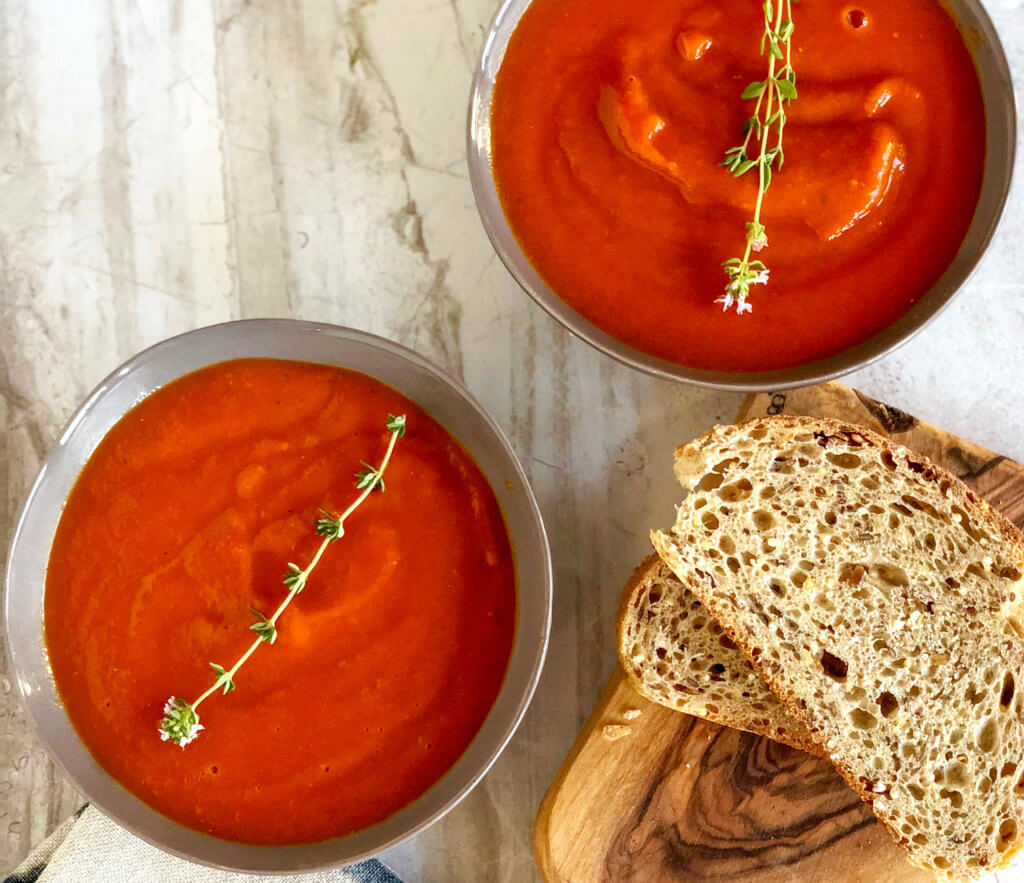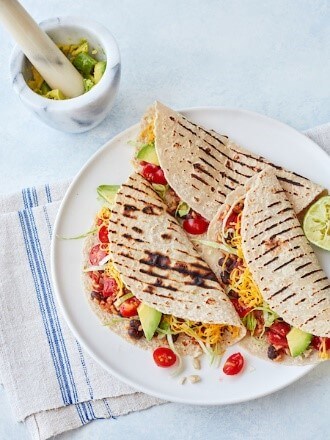Maximize the Many Benefits of Family Meals

Expert Dr. Julia Nordgren, pediatrician, chef, and author shares her best tips on how to maximize the benefits of family meals.
Did you know that the simple act of gathering together around the dinner table can lead to many powerful benefits for your family? From eating a more healthful, nutritious diet to feeling more emotionally balanced and achieving better academic performance, the rewards are plenty. That’s why I’m such a huge fan of gathering your family together more often around the dinner table. However, it can be challenging to take this action, given our busy schedules, which pack in after school sports and activities, homework, shopping, and chores.
That’s why I’m excited to sit down with acclaimed health expert Dr. Julia Nordgren, pediatrician, chef, and author of The New Family Table: Cooking More, Eating Together & Staying (Relatively) Sane, to learn more about her best tips on how to maximize the benefits of family meals. She has some of the very best advice to offer on dining together as a family. Julia is answering your top questions, including why family meals are on the decline, strategies to help families gather together more often, and how you can make time for a sit-down meal. We are so lucky to have her with us to share her words of wisdom.

How to Maximize the Benefits of Family Meals with Dr. Julia Nordgren
Sharon: What is the impact of eating family meals together?
Julia: There are several facets to the positive impact of eating together.
First, is the quality of the meal. With very rare exception, any meal made at home is going to be more nutritious than take-out or eating out at a restaurant. A simple meal at home will almost always cost less, have a better nutrient profile, and be lower in salt and preservatives – and in my view, more delicious!
Also important is the social connection that comes from sitting and eating together. Gathering around the table is one of the longest-held traditions of human civilization and happens in every country, every culture. Cultures that highly value the social connection of mealtime, like Mediterranean cultures, often have healthier, more vibrant populations.
In our day and age, it is a time to set aside our devices and task lists and check in with the people we care most about. It is a setting where children learn so much about the way their parents communicate with each other, what behaviors are accepted and not, and how to express interest in each other. Children learn so much by watching how their parents and siblings navigate the struggles – and successes – of the day. Eating together forms a critical foundation of family connection.
There are studies that show eating together as a family is protective for kids – they are at less risk for substance abuse, risky behaviors, and depression. Family meals alone won’t protect our children from these issues, but they allow us to tune in – and respond to – the changing emotional states of our growing children.
Sharon: Why is the habit of families dining together at the end of the day on the decline? What is the significance of this to health?
Julia: The factors I see impacting mealtime the most are:
- Long Commute Times. If a parent, or parents, aren’t getting home until 6:30 p.m. or later, dinnertime often gets fragmented.
- Extracurricular Activities. If baseball practice goes from 5 p.m. to 7 p.m., that often means families eat separately (and siblings eat at the park snack bar!).
- Professional Demands. I often see parents having to work until well after dinnertime, or have to interrupt meals to take calls or answer texts. While it might be great to be able to reach anyone, anytime with a text or a call, that also means we have to be deliberate about making everything else wait while we share a meal with our families.
In terms of health, I see a general trend that families who eat more fragmented meals (and specifically, more food eaten outside the home) tend to have more issues with high cholesterol, prediabetes, and unwanted weight gain.

Sharon: What are some of the strategies that parents can employ to help gather their families together more often?
Julia: Set the expectation very early that the family eats together whenever possible. Set the habit for everyone – that NOT eating together is the exception, not the rule!
Create a media-free table where invasions and interruptions aren’t welcome. While this can be hard at first, it teaches everyone to hold that time sacred. Kids really love – and need – having our undivided attention. And we love – and need – theirs!
Have a weekly “family meeting.” This is a chance to discuss the schedule of the week, who is around, what activities are happening, and what time dinner should be each night to get the most people around the table. This is also a great time to meal plan and get kids’ input into what meals they want for the week.

Sharon: How can busy families make time to plan healthful, plant-based meals for their families?
Julia:
- Plan ahead! Use the “Family Meeting” tip to cover the planning topics of the week – meals especially. Time spent thinking ahead pays off huge dividends – it is so much harder to be creative when you are hungry and rushing home from work! It is so much to pull dinner together when the ingredients are there and prepped in advance.
- Prep ahead! Even just slicing ahead the vegetables for the night.
- Hit the weekly farmer’s market. Ask the vendors how they eat the foods they are selling. I always find they have great tricks on how to get the best flavor out of fresh vegetables and fruits without a lot of fuss!
- Make a soup every week. This is a great way to use up the veggies you have in the fridge and make something hearty and inviting for meals and snacks.
- Consider a meal-kit delivery service. The popularity of these is on the rise and can save a lot of time and many have options that suit a vegetarian, gluten-free, or vegan.

Sharon: What plant-based foods should be the foundation for meals, and should be in the pantry at all times?
Julia:
- Any kind! Having lots of canned (or fresh) beans on hand means a hearty base for a meal is within reach. This is one of the great benefits of the popularity of pressure cookers (like the Instapot). Fresh beans don’t need hours to cook!
- Farro – one of my favorite whole grains. I like to cook a big batch in advance, separate into smaller batches, and freeze.
- Boxed or canned tomatoes. These can be the foundation for a quick homemade pasta sauce, a tomato soup, or a veggie chili. They are so versatile.
- Frozen fruit – a must to top steel-cut oats in the morning. Raspberries and wild Maine blueberries are my favorite.
- Frozen veggies – edamame beans, peas, and corn are always in my freezer.
Sharon: What are some easy, no-recipe meals that families can whip up together in 30 minutes or less?
Julia:
- Farro with sautéed vegetables (like onion, pepper, zucchini)
- Tofu lettuce wraps with grated carrot
- Whole grain quesadillas with black beans and avocado
Sharon: How can the habit of bringing families together for one healthful meal a day create impact over one’s lifetime?
Julia: I really believe in the emotional connectedness that comes from eating together regularly. We learn so much about each other by paying attention, tuning in, and meeting each other where we are in our day. It creates a safe and open space to talk – or not talk. It can be a time tell jokes or catch up on news. Or dream about the ideal vacation.
About Dr. Julia Nordgren
Julia is a pediatrician, trained chef, and author of The New Family Table: Cooking More, Eating Together & Staying (Relatively) Sane. Her years of treating patients for cholesterol disorders, prediabetes, and childhood obesity are what motivated her to enroll in the Culinary Institute of America’s Accelerated Culinary Arts Certificate Program, where she graduated with honors. Since then, Julie has helped countless families move the needle on becoming more intentional about their eating, while developing sustainable and impactful lifestyle changes. Julia maintains a vibrant pediatric weight management practice at Palo Alto Medical Foundation and leads a hands-on Culinary Medicine class at the Stanford University Teaching Kitchen. Julia received her medical degree from Dartmouth Medical School, completing her pediatrics residency at Dartmouth-Hitchcock Medical Center, where she was elected Chief Resident. She lives and practices medicine in Palo Alto, where she tests many of her recipes on her husband and two boys, who luckily have adventurous appetites and honest opinions. You can find Julia on Facebook and Instagram.
Here is one of Julia’s favorite recipes for Cauliflower Tacos.

Serves 1
12 (6-inch) whole-grain tortillas
1 tablespoon of olive oil
1 small yellow onion, diced
3 cloves of garlic, minced
2 teaspoons chili powder
1 teaspoon smoked paprika
2 cups riced cauliflower
½ cup of water
1 can black beans, drained and rinsed
1 can diced tomatoes, with juice
½ teaspoon kosher salt
Ground pepper
1. Prepare all the toppings and set on the table in individual bowls.
2.Wrap the stack of tortillas in foil and put in the oven to warm while preparing the filling.
3. Heat a sauté pan over medium heat. Add oil. When oil is shimmering, add onion and sauté until translucent, about 5 minutes. Add garlic and sauté a minute more. Add chili powder and smoked paprika. Stir until fragrant, 1 to 2 minutes.
4. Add cauliflower and water. Cook, stirring occasionally, until water evaporates and cauliflower softens, about 5 minutes. Add beans, tomatoes, salt, and pepper Stir and cook for 15 minutes, until liquid from the tomatoes evaporates and the mixture is heated through. Taste and add more salt and pepper if needed.
5. Serve the spiced beans and cauliflower mixture in warm tortillas, and allow everyone to dress them at the table.
Check out some of Sharon’s favorite blogs on family cooking:
Gather Together for Family Meals and Reap the Rewards
Get Cooking with Your Kids (The Plant-Powered Way)


